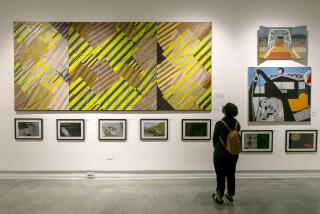Solution to a Squiggle : College Professor Clears Up 450-Year-Old Michelangelo Mystery
- Share via
Thanks to a discovery by an Orange Coast College art professor, California has a connection to Michelangelo.
Victor Gabriel Casados, art department chairman at the community college in Costa Mesa, solved a 450-year riddle about a squiggle on a Michelangelo drawing last summer in London. That discovery was formally acknowledged in November by the British Museum in London, which has the original drawing.
“I wasn’t looking at it to solve a puzzle,” Casados said Friday. “But when I saw the drawing, it was so clear to me what it was. Because, you see, I teach life drawing. I teach anatomy with it. That kind of imagery (on the previously unsolved Michelangelo squiggle) is the kind of imagery I work with all the time.”
Unidentified Squiggle
The squiggle that Casados identified was a fragment of a “study,” or preliminary drawing, that Michelangelo (1475-1564) sketched on paper in his later years in Rome. The study, in black chalk, is called “The Raising of Lazarus” and is kept under guard in the British Museum.
The study shows a nude Lazarus rising from death. Beneath the drawing, Michelangelo made several sketches of feet. And to the right of these was an oval-shaped mass. It was this oval configuration which had mystified the art world for more than four centuries.
Casados was at the British Museum in June to study, first hand, the priceless Michelangelo drawings, including “The Raising of Lazarus.”
“At the bottom of the page accompanying this drawing, I read that ‘the subject cannot be made out,’ ” Casados recalled.
“But when I saw it, I knew it was a right human shoulder, viewed from above, without the head.”
Casados went immediately to the woman in charge of the drawings at the museum. “She immediately followed me to the drawing, and I said: ‘Look, this is the deltoid, this is the trapezius, the scapula, the clavicle. . . .’ I pointed out all the parts. And she looked at me and said: ‘You’re right.’ ”
Catalogued and Credited
On Nov. 13, Nicholas Turner, assistant keeper of the British Museum’s department of prints and drawings, wrote Casados that the discovery was being formally catalogued and credited to the Orange Coast College professor.
Casados, 50, who has been with Orange Coast College since 1967, said the “Lazarus” drawing has long been a favorite of his and one that he frequently has referred to in his teaching of college art students. “This is the kind of drawing that the old masters would do in preparation for paintings they would do later on,” Casados said. “Michelangelo, in this study, drew several feet at the bottom, and in frustration, tried to cross out one of them. I often have shown this study to my students, saying: ‘See, even the masters found frustration. It isn’t always easy.’ ”
Casados said the “Lazarus” study probably was used by Michelangelo “in teaching anatomy to some of his students.”
A native of Santa Fe, N.M., and now a resident of Costa Mesa, Casados is a graduate of the Art Center College of Design and Otis Art Institute. He said that he gained special permission from the British Museum, as an art instructor, to see the Michelangelo drawings, which are not on view to the general public.
‘Difficult to Describe’
“To see them, to be close to them, is difficult to describe,” Casados said. “Perhaps it would be like a baseball fan’s going to the Baseball Hall of Fame in Cooperstown, N.Y., and seeing Babe Ruth’s bat. For me, it was being close to that master draftsman and realizing what he was trying to do.”
Casados said that while he was pleased at his discovery, he didn’t think much about it. Later, however, as word filtered out about the discovery, Casados said that “people, including people I didn’t know, would come up to me and congratulate me. . . . I began to realize the significance.”
He plans to return to London and view the Michelangelo drawing.
“For me, a person who loves drawing, to be able to contribute something like this to the world of art is a great honor,” he said.
More to Read
Sign up for Essential California
The most important California stories and recommendations in your inbox every morning.
You may occasionally receive promotional content from the Los Angeles Times.











